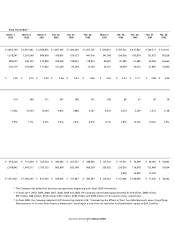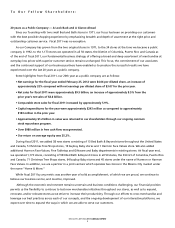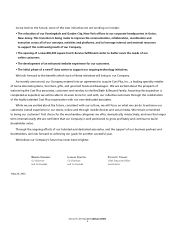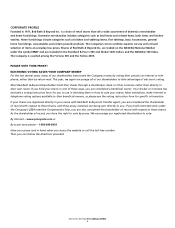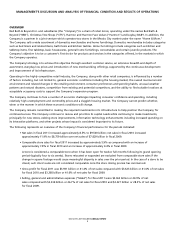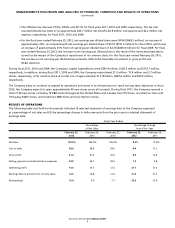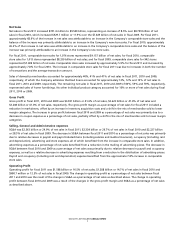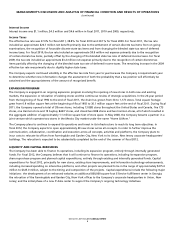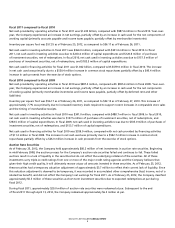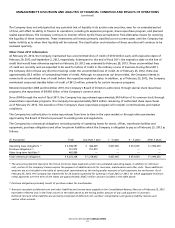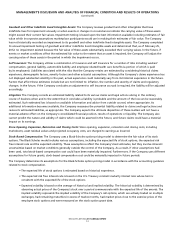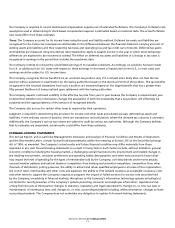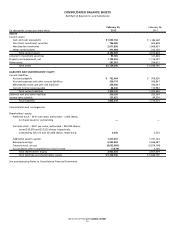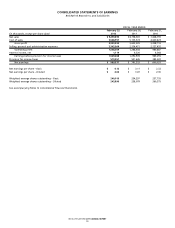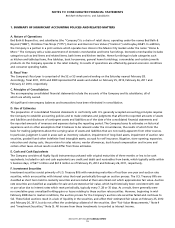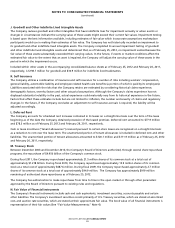Bed, Bath and Beyond 2011 Annual Report Download - page 13
Download and view the complete annual report
Please find page 13 of the 2011 Bed, Bath and Beyond annual report below. You can navigate through the pages in the report by either clicking on the pages listed below, or by using the keyword search tool below to find specific information within the annual report.BED BATH & BEYOND 2011 ANNUAL REPORT
SEASONALITY
The Company’s sales exhibit seasonality with sales levels generally higher in the calendar months of August, November
and December, and generally lower in February.
INFLATION
The Company does not believe that its operating results have been materially affected by inflation during the past year.
There can be no assurance, however, that the Company’s operating results will not be affected by inflation in the future.
CRITICAL ACCOUNTING POLICIES
the Company to establish accounting policies and to make estimates and judgments that affect the reported amounts of assets
and liabilities and disclosure of contingent assets and liabilities as of the date of the consolidated financial statements and
the reported amounts of revenues and expenses during the reporting period. The Company bases its estimates on historical
experience and on other assumptions that it believes to be relevant under the circumstances, the results of which form the basis
for making judgments about the carrying value of assets and liabilities that are not readily apparent from other sources. In
particular, judgment is used in areas such as inventory valuation, impairment of long-lived assets, goodwill and other indefinite
lived intangible assets, accruals for self insurance, litigation, store opening, expansion, relocation and closing costs, stock-based
compensation and income and certain other taxes. Actual results could differ from these estimates.
Inventory Valuation: Merchandise inventories are stated at the lower of cost or market. Inventory costs for BBB, buybuy BABY
and Harmon are calculated using the weighted average retail inventory method and inventory costs for CTS are calculated using
the first in first out cost method.
a cost-to-retail ratio to the retail values of inventories. The cost associated with determining the cost-to-retail ratio includes:
insurance and commissions.
At any one time, inventories include items that have been written down to the Company’s best estimate of their realizable value.
Actual realizable value could differ materially from this estimate based upon future customer demand or economic conditions.
The Company estimates its reserve for shrinkage throughout the year based on historical shrinkage and any current trends,
if applicable. Actual shrinkage is recorded at year end based upon the results of the Company’s physical inventory counts for
locations at which counts were conducted. For locations where physical inventory counts were not conducted in the fiscal year, an
estimated shrink reserve is recorded based on historical shrinkage and any current trends, if applicable. Historically, the Company’s
shrinkage has not been volatile.
for merchandise in transit is included in the Company’s merchandise inventories.
Impairment of Long-Lived Assets: The Company reviews long-lived assets for impairment when events or changes in
circumstances indicate the carrying value of these assets may exceed their current fair values. Recoverability of assets to be held
and used is measured by a comparison of the carrying amount of an asset to the estimated undiscounted future cash flows
expected to be generated by the asset. If the carrying amount of an asset exceeds its estimated future cash flows, an impairment
charge is recognized for the amount by which the carrying amount of the asset exceeds the fair value of the assets. Assets to be
disposed of would be separately presented in the balance sheet and reported at the lower of the carrying amount or fair value
less costs to sell, and are no longer depreciated. The assets and liabilities of a disposal group classified as held for sale would
be presented separately in the appropriate asset and liability sections of the balance sheet. The Company has not historically
recorded any material impairment to its long-lived assets. In the future, if events or market conditions affect the estimated fair
value to the extent that a long-lived asset is impaired, the Company will adjust the carrying value of these long-lived assets in the
period in which the impairment occurs.


